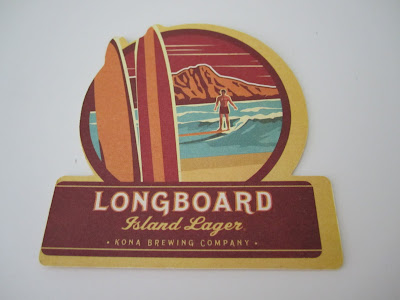
A friend and fellow fiction fan from work loaned me "Murder on Moloka'i," the first in the "Surfing Detective" series by local author
Chip Hughes. The book features Kai Cooke, a PI whose other passion in life is surfing. The book is a murder-mystery about an environmental activist who dies while on Moloka'i's mule tour to the leper colony at Kalaupapa. Her mule trips and falls, pitching her off a cliff, and her (estranged) sister doesn't think it was an accident.
The writing and plot were decent, not the best or most original murder-mystery I've ever read but still an enjoyable book. I really liked the Hawaiian element, though. I watch "Hawaii 5-0" (not quite the best show on TV right now) occasionally for the same reason -- it's neat to read about and see places we've been or want to go. This book includes scenes on several Hawaiian islands. Incidentally, my friend gave me the book at the exact time I had been researching a quick getaway to Moloka'i. The island sounds like the antithesis to bustling, over-populated Oahu. It's uncrowded, has pristine and unspoiled beaches, and doesn't even have a stoplight. The scenery appears to be stunning, and I have no doubt that the atmosphere would be relaxing. Other than lounging on the beach, we'd like to take the mule ride to Kalaupapa and visit the leper colony there. "Murder on Moloka'i" includes some history on Saint Damien and the colony, which I'll be glad to know going into the tour. Conditions at Kalaupapa were horrible for the exiled lepers, until Saint Damien began caring for patients there in 1873 and made it his mission to drastically improve their quality of life. After years of dedication to the quarantined patients, he succumbed to the disease himself and died in 1889.
Aside from giving readers a history lesson, Hughes does a great job depicting Hawaiian culture and the atmosphere of the islands. I enjoyed his usage of Pidgen and Hawaiian words, although readers unfamiliar with the language might need to look up a few terms. Hughes does italicize most Hawaiian words, and they can often be figured out in context. Here are some common Hawaiian words used in the novel:
-akamai: smart
-moke: big, local Polynesian guy (as in physically huge)
-ono: delicious, as in food (i.e. ono grinds); hot/sexy, as in physical attractiveness (ono wahine)
-wahine: woman
-kane: man
-mahu: homosexual
-haole: white/Caucasian person
-pali: cliffs
-paniolo: Hawaiian cowboy
-ohana: family
-aina: land
-mahalo: thank you
I'm planning to soon read the next two books in the series, "Wipeout" and "Kula." The latter book deals with a surfing dog, and since dogs are a topic close to my heart I'm looking forward to this book in particular. I'd definitely recommend reading Chip Hughes' series for a taste of the islands!






 As soon as the first bites were in our mouths, our tongues were saying, "How could you go 18 months without treating us to this amazing melding of flavors?" and meanwhile our waistlines were saying, "Uh-oh..."
As soon as the first bites were in our mouths, our tongues were saying, "How could you go 18 months without treating us to this amazing melding of flavors?" and meanwhile our waistlines were saying, "Uh-oh..." Each mochi ice cream is about the size of a small clementine. The mochi itself -- made of smashed, sweetened rice -- is a bit sticky, so each ball is dusted in flour. The mochi is sweet, chewy and has a mellow but unique flavor. And inside that is a ball of vanilla ice cream. (Or whatever flavor you choose.)
Each mochi ice cream is about the size of a small clementine. The mochi itself -- made of smashed, sweetened rice -- is a bit sticky, so each ball is dusted in flour. The mochi is sweet, chewy and has a mellow but unique flavor. And inside that is a ball of vanilla ice cream. (Or whatever flavor you choose.)







